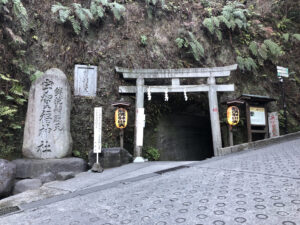Nihombashi Bridge
Nihombashi Bridge is kilometre zero of the Japanese National Highway Network, dating back to 1604, depicted in a number of popular Ukiyo-e prints by Hiroshige and Keisai Eizawa. The Nihombashi Bridge dates from 1603 and became the starting point of Japan’s five main highways, –the Tokaido, the Nakasendo, Nikko Kaido, the Oshu Kaido, and Koshu Kaido. The original Nihombashi Bridge, built in 1603, was the east end of the Tokaido Road connecting Tokyo, then known as Edo, to Kyoto.
The name Nihombashi also referred to the namesake bridge, which is the symbol of the nation as the start point for the five main roads leading to and from Tokyo. Today, the bridge bears a bronze marker bearing the words “origin of roads in Japan”, while Nihombashi is used as the basepoint for measuring distances to Tokyo. Today, the bridge stands veiled and (literally) obscured by the elevated Shuto Expressway, which follows the old canal.
Now 100 years old, the Nihonbashi is still considered to be Japan’s premier bridge. Literally meaning Japanese bridge, the Nihonbashi bridge was built in 1603 by Tokugawa Ieyasu, founder of the Tokugawa Shogunate, across the Nihonbashi-gawa river, just to the north of Chuo Ward, in Tokyo. The Nihonbashi bridge itself served as a terminus of Japan’s five Gokaido roads, allowing an increasingly large stream of people and goods to enter and exit the city that became Tokyo.
Now, Tokyo’s working to eliminate an elevated section of the Metro Expressway, which runs along the historic Nihonbashi bridge. The Metro Expressway The historic Nihonbashi bridge. When we heard last week that the work was beginning on removing the section of the Metropolitan Expressway Tokyo’s is running across the historic Nihombashi bridge the Metropolitan Expressway the Nihombashi bridge, we wasted little time getting down to the historic bridge to get some photos, as a portion of the culpable expressway mostly remains in place. The Nihombashi Bridge will again see daylight in the 2040 tax year, as work begins on the removal of an expressway that crosses over Tokyo’s historical landmark.
The plans for the Nihombashi Bridge and surrounding areas would ultimately result in remaking the 1.8-kilometer long Shutoko from the junctions at Kandabashi to Edobashi. A complete replica of the Nihombashi Bridge is available to be seen (and crossed) in the Edo-Tokyo Museum in Ryogoku, and a half-sized replica is available to view at Haneda Airports international terminal. In the Meiji Era, the early wooden bridge was replaced with a larger, stone one that is still standing (a replica of the older bridge is on display at the Edo-Tokyo Museum).
This granite, double-arched, Renaissance-style bridge, a symbol of Tokyo’s Nihombashi neighborhood today, was designated a Cultural Heritage of Japan in 1999. Although Nihonbashi was the bustling centre of Tokyo’s commerce during the Tokugawa period, Tekikos painting highlights instead the bridges construction of 1911.
Way to Access Nihombashi
Train
Tokyo Metro Ginza Line / Tozai Line
“Nihombashi Station.”
Toei Asakusa Line
“Nihombashi Station.”
JR Lines
Tokyo Station 9 minutes walk.
Bus
Metrolink (Free Shuttle Bus)
Tokyo – Yaesu – Kyobashi – Nihombashi
AM10:00~PM8:00 About 10 minutes interval.
Chuo-ward Community Bus North Route
Yaesu – Nihombashi – Ningyocho – Hachobori – Chuo-ward office
Adult: 100yen. Suica/Pasmo usable
Car
Nihombashi-Parking
30minutes / 200yen
Under 30 minutes Free
*Basement parking without ground entrance.
Informations
| Business Hour | 24 hours |
| Cost | Free |
Used as a part of a public road.









